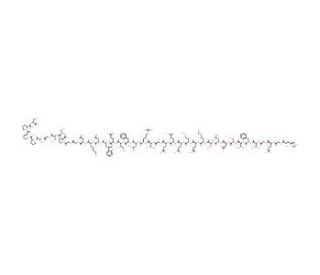

Exendin-4 의 분자 구조, CAS 번호: 141758-74-9
Exendin-4 (CAS 141758-74-9)
인용논문 보기 (1)
대체 이름:
Exendin-4 is also known as Exenatide.
적용:
Exendin-4 은 39개 아미노산 폴리펩타이드, 인크레틴 모방체, GLP-1R 작용제 및 인슐린 분비 촉진제입니다.
CAS 등록번호:
141758-74-9
순도:
≥97%
분자량:
4186.57
분자식:
C184H282N50O60S
연구용으로만 사용가능합니다. 진단이나 치료용으로 사용불가합니다.
* Refer to Certificate of Analysis for lot specific data.
빠른 링크
주문정보
논문정보
설명
기술정보
안전정보
SDS 및 분석 증명서
Exendin-4는 인슐린 분비의 포도당 의존적 증진에 관여하는 39개의 아미노산 폴리펩티드 및 인크레틴 모방체이다. 또한 고혈당 감소, 부적절하게 높은 글루카곤 분비의 포도당 의존적 억제, 위 배출의 둔화 및 음식 섭취의 감소를 촉진하며, 종종 체중 감소 또는 체중 증가의 둔화를 동반한다. Exendin-4는 GLP-1R 작용제로 반감기가 길며 인슐린 자극제로 작용한다. 원래 길라 괴물 도마뱀인 Heloderma suspectum에서 유래하였다.
Exendin-4 (CAS 141758-74-9) 참고자료
- 엑센딘-4는 베타 세포 복제와 신생을 모두 자극하여 당뇨병 쥐의 베타 세포 질량을 증가시키고 내당능을 개선합니다. | Xu, G., et al. 1999. Diabetes. 48: 2270-6. PMID: 10580413
- 헬로더마 독에서 엑센딘-3 유사체인 엑센딘-4의 분리 및 특성 분석. 기니피그 췌장의 분산된 아치니에서 엑센딘 수용체에 대한 추가 증거. | Eng, J., et al. 1992. J Biol Chem. 267: 7402-5. PMID: 1313797
- 엑세나타이드 치료는 제2형 당뇨병 마우스 모델에서 불안 완화 및 항우울제 유사 효과를 발휘하고 신경 병증을 역전시킵니다. | Komsuoglu Celikyurt, I., et al. 2014. Med Sci Monit Basic Res. 20: 112-7. PMID: 25076419
- 엑세나타이드는 알츠하이머병의 5×FAD 마우스 모델에서 미토콘드리아 기능 장애와 인지 장애를 완화합니다. | An, J., et al. 2019. Behav Brain Res. 370: 111932. PMID: 31082410
- 엑세나타이드는 심장사 후 기증된 신장을 사용한 쥐 이식 모델에서 이식편 손상을 감소시킵니다. | Hua Yang, ., et al. 2019. Transplant Proc. 51: 2116-2123. PMID: 31303407
- 서방형 PT320 및 바이두레온 형태로 투여한 후 비인간 영장류에서 엑세나타이드의 약동학. | Li, Y., et al. 2019. Sci Rep. 9: 17208. PMID: 31748513
- 엑세나타이드는 통행세 유사 수용체 4/NFκB 신호 억제를 통해 쥐의 실험적 비알코올성 지방간을 개선합니다: 메트포르민과 비교. | Saad, ZA., et al. 2020. Life Sci. 253: 117725. PMID: 32348835
- 엑세나타이드는 TFE3 매개 자가포식 증강을 통해 무작위 패턴 피부 플랩 생존을 개선합니다. | Li, J., et al. 2021. J Cell Physiol. 236: 3641-3659. PMID: 33044023
- 엑세나타이드는 파이로프토시스 신호 전달 경로를 억제하여 비알코올성 지방간염을 약화시킵니다. | Liu, Y., et al. 2021. Front Endocrinol (Lausanne). 12: 663039. PMID: 33953700
- 엑세나타이드는 METTL3 매개 m6A 메틸화 조절을 통해 과산화수소로 인한 췌장 베타세포 세포 사멸을 개선합니다. | Zhou, S., et al. 2022. Eur J Pharmacol. 924: 174960. PMID: 35436474
- 엑세나타이드와 두 가지 장 투과 개선제 간의 물리화학적 상호작용 특성 분석: 카프레이트나트륨(C10) 및 살카프로자이트나트륨(SNAC). | Twarog, C., et al. 2022. Int J Pharm. 626: 122131. PMID: 36028084
- 엑세나타이드는 지방 형성을 억제하여 지방 세포에서 CTRP3 유전자 발현을 증가시키고 세포 사멸을 유도합니다. | Koldemir Gündüz, M., et al. 2022. Toxicol In Vitro. 85: 105479. PMID: 36152787
- 엑세나타이드는 db/db 마우스에서 PI3K/Akt/FoxO1 경로를 통해 Th17/Treg 균형을 조절합니다. | Xu, Q., et al. 2022. Mol Med. 28: 144. PMID: 36463128
의 억제제:
Angptl5, APPL2, C20orf117, CDKAL1, cHMGCS, CTRP7, EG329055, GADD 153, GCG, GIP, GPR119, granuphilin, Olr1591, Peptide YY3, PGC-1α, SLC30, SSTR3, TUSC5, ZnT-6, ZnT-8.의 활성화자:
ACBD4, BRIDGE-1, CEACAM6, CTRP4, FAS, GIPR, Gl Syn, GLP-1R, GLP1, Glucagon Receptor, INSL5, Insulin, Insulinm Solution, Pax-4, Reg Iβ, Rho T2, Rtl1, TIP47, YSK1.주문정보
| 제품명 | 카탈로그 번호 | 단위 | 가격 | 수량 | 관심품목 | |
Exendin-4, 500 µg | sc-474611 | 500 µg | $143.00 | |||
Exendin-4, 1 mg | sc-474611A | 1 mg | $194.00 |
